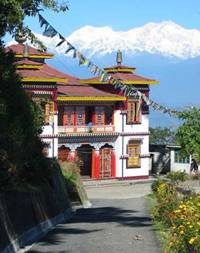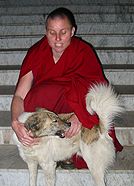Darjeeling – admire mountains from a seat in
the clouds

Rodney
Appleyard and Dan Thory have
headed north to the mountains and are inspired by views of the 'abode
of the gods' – the Himalayan mountains – and the fascinating
sites in and around Darjeeling.
Don't try looking for food or drink in Darjeeling
after 10 p.m., because you won't find anything, and you'll probably
get lost in the dark streets when the street lamps get turned off
at this time too. Even if you do stay awake and try to have a conversation,
you will find yourself whispering, hoping desperately that you won't
wake up anybody nearby.
But it's worth it, because people in Darjeeling live
for the day, not the night, and you'll do exactly the same after
a couple of days. There is so much to see and do between the hours
of sunrise and sunset
Our first night was spent at the Aliment Hotel, which
featured a roof top view of the Himalayan mountain range, including
Mount Everest. The landlord warned us that he would wake us up at
5.30 a.m. the following day so we could see the mountains at sunrise.
He stuck to his word and what a beautiful site it was too! We watched
the light reflect its early morning colours on top of Kanchanjunga,
the third tallest mountain in the world. This was enough to get
us addicted to the early-to-bed and early-to-rise policy of Darjeeling,
so we immediately agreed to get up even earlier for the big one
– a trip to 'Tiger Hill' at 4.30 a.m.
Tiger Hill
Tiger Hill is a very famous spot where crowds gather every cloudless
morning to watch an even clearer view of the sun rising over the
whole mountain range. This view, from 8,482 feet high, includes
a view of Mount Everest's peak.
Apart from the opportunity of trekking up mountains
through the clouds and white water rafting the rivers in the valleys,
there are many fascinating things to do in and around Darjeeling.
Darjeeling Zoo
 Even
if you don't believe in keeping animals in captivity, Darjeeling
Zoo is worth a visit because they protect endangered species, including
some of the most unusual animals in the world. Amongst these are
Red Pandas, Siberian Tigers, Yaks, Snow Leopards and Himalayan bears.
We felt that the Red Pandas were by far the most fascinating of
all of these creatures; these appealing animals live almost entirely
on a diet of bamboo and their natural habitats are the bamboo forests
of the Himalayan mountains, extending through Nepal, Bhutan, Tibet,
Burma, and Sichuan and Yunnan provinces in western China. The loss
of this natural habitat has put them on the endangered list. Even
if you don't believe in keeping animals in captivity, Darjeeling
Zoo is worth a visit because they protect endangered species, including
some of the most unusual animals in the world. Amongst these are
Red Pandas, Siberian Tigers, Yaks, Snow Leopards and Himalayan bears.
We felt that the Red Pandas were by far the most fascinating of
all of these creatures; these appealing animals live almost entirely
on a diet of bamboo and their natural habitats are the bamboo forests
of the Himalayan mountains, extending through Nepal, Bhutan, Tibet,
Burma, and Sichuan and Yunnan provinces in western China. The loss
of this natural habitat has put them on the endangered list.
 The
Darjeeling Tea Plantation The
Darjeeling Tea Plantation
The Darjeeling Rangeet Valley Passenger Ropeway service (the first
of its kind in India), carries you over the Darjeeling Tea Plantation
via cable car. Here they are reputed to make the best tea in the
world. Once you are travelling over the plantation, you can watch
people below you picking the tea leaves, and can then enjoy a cup
at the bottom, amongst a breathtaking view of the valleys and mountains.
The Mount Everest Mountaineering Institute
Just north of the Zoo is the Mount Everest Mountaineering Institute,
which contains invaluable exhibits and artefacts from travellers
and climbers from all over the world who have conquered Everest.
Tenzing Norgay (Sherpa), who together with Edmund Hillary was one
of the first people to set foot on the summit of Everest, lived
in Darjeeling for much of his life. Tenzing Norgay was one of the
founding members of the Mount Everest Mountaineering Institute and
was also its Field Director.
 Darjeeling
monasteries Darjeeling
monasteries
Darjeeling is surrounded by beautiful monasteries built in idyllic
and remote locations. The monks are very content here because they
are isolated enough to meditate and are inspired by the environment.
We met an Australian woman who had decided to become a Buddhist
nun in Darjeeling. Aniyang chen, as she is now known, told us why
Darjeeling is such a special place for monks and nuns:
 Aniyang
chen: "I have been in Darjeeling for two years. I first
read about the Dali Lama's teachings in Australia 10 years ago
and I came here because of the special Tibetan language school
and Darjeeling's interesting Buddhist history. Aniyang
chen: "I have been in Darjeeling for two years. I first
read about the Dali Lama's teachings in Australia 10 years ago
and I came here because of the special Tibetan language school
and Darjeeling's interesting Buddhist history.
A monk once meditated for days/weeks next to a holy stone, which
is called 'Dorje' in Tibet. His dedication and sacrifice made
a huge impression on the people, and Darjeeling's name is derived
from the word 'Dorje', based on this story. The monk made this
place sacred and both Hindus and Buddhists now worship at this
spot, which is called Observatory Hill.
Many Tibetans fled Tibet in 1959 to live in India. The higher
Lamas settled in Darjeeling and set up monasteries, which is why
there is a strong Buddhist presence here now."
Darjeeling is ideally set up for tourism and there
are numerous trekking opportunities, but the scenery and the lifestyle
of the locals and Buddhists is equally fascinating. In Darjeeling
you can feel a part of the community very quickly – because
everybody seems proud to live in the clouds.
Text © Rodney Appleyard, photographs
© Dan Thory, 2003
|

